According to oral histories, the Athapaskan people of southern Oregon and northern California arrived from the north in ancient times, traveling by canoe.
In the mid-nineteenth century the Chetco and Tututni Indians wore no clothing except a robe of deer skins dressed with the hair on. The women wore a mat of grass or bark split into threads and fastened around their hips and hanging down to their knees, while the children were almost naked. They were intelligent, and made no complaints at the encroachments of the white men. Their only weapons were the bow and arrow, and large knives flattened out from bolts and strips of iron, taken from the drift of wrecked vessels. Some of their axes and knives were made from stone and flint. Their cooking was done by roasting before the fire or in pots, made airtight with grass and heated with hot stones. Fish, acorns, elk and deer meat were their principal sources of subsistence. The Indian town, at the mouth of the Chetco River, consisted of about 40 houses, located on both sides of the river. They were expert canoe men on both river and ocean.

